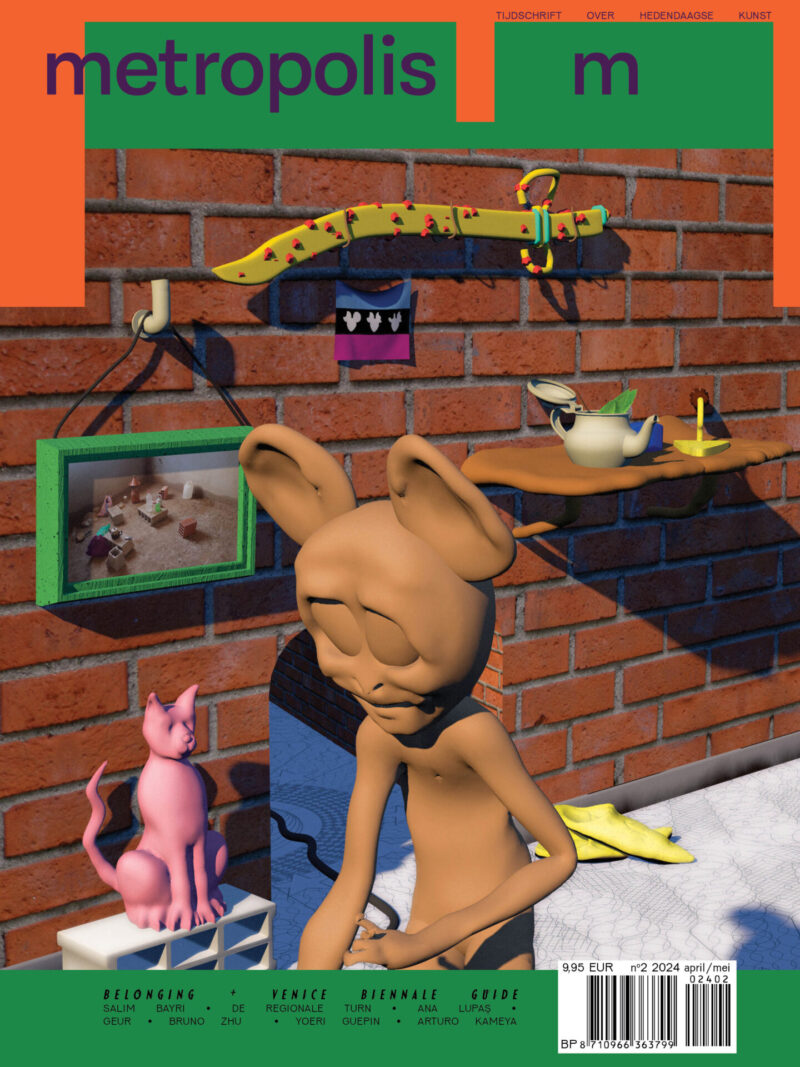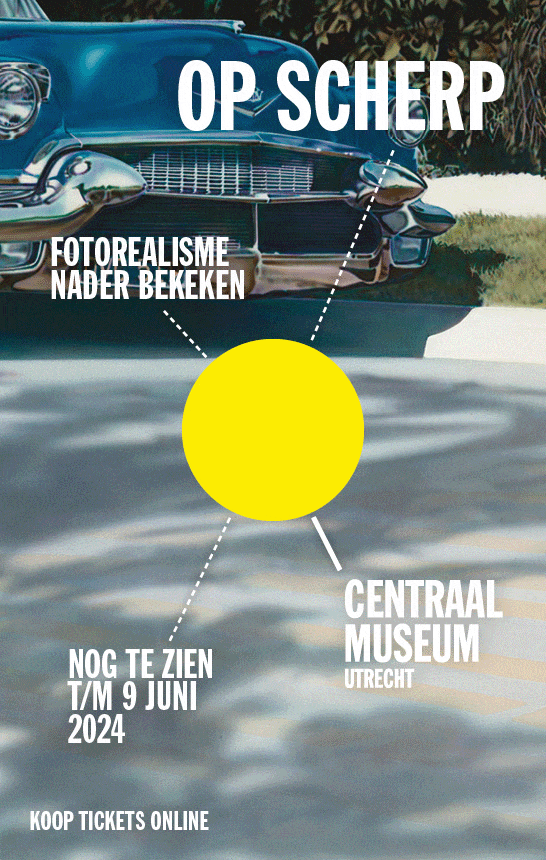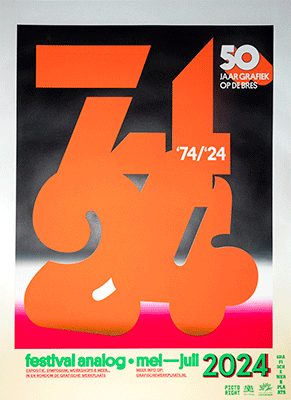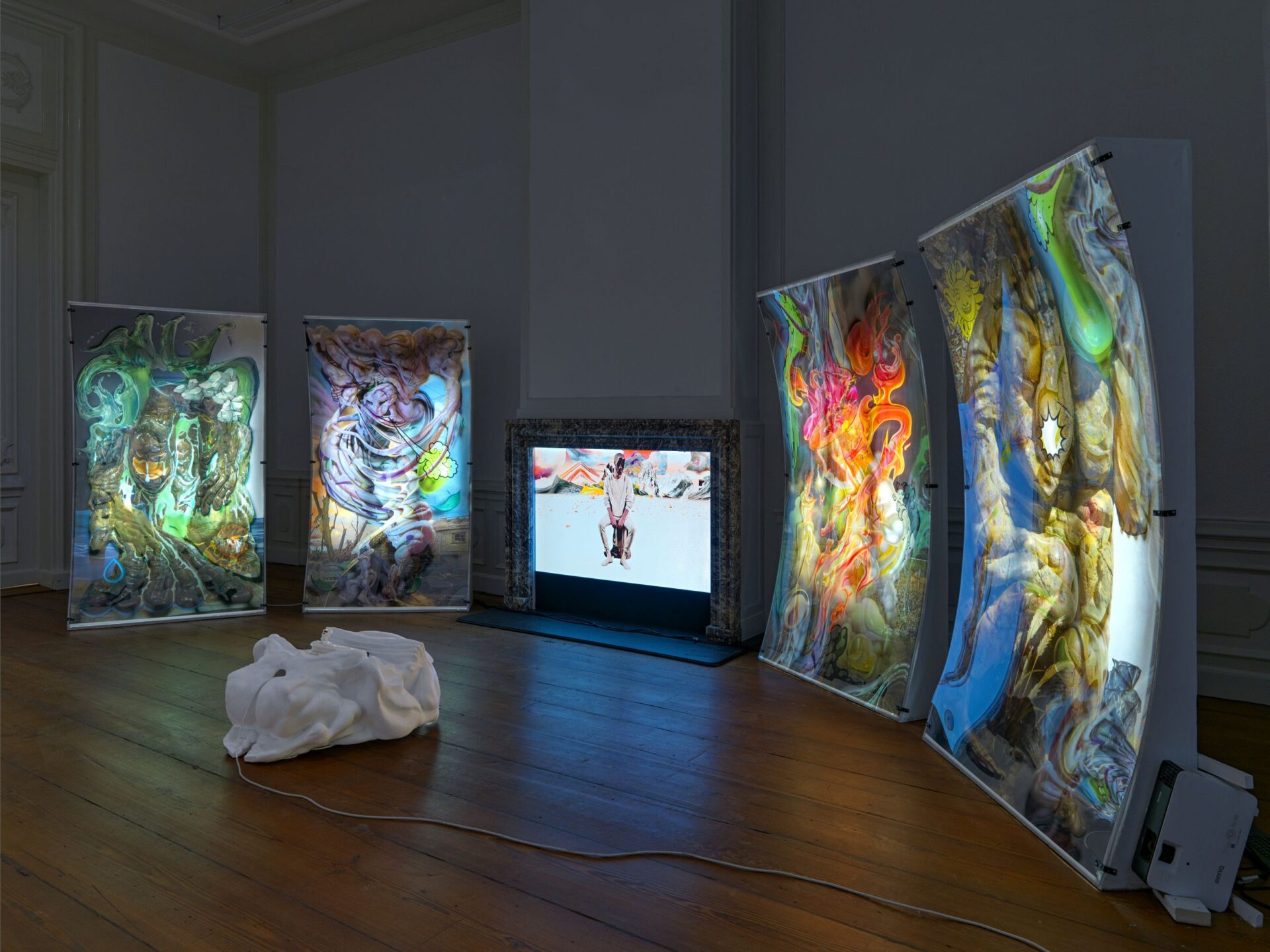
Kévin Bray, overview ‘The Collective Shadow’, photo’s by Gert Jan van Rooij, courtesy Upstream Gallery
Shadow-work: Kévin Bray’s ‘The Collective Shadow’ at Upstream Gallery
Kévin Bray is a master of projection. In his first solo exhibition, The Collective Shadow, currently on view at Upstream Gallery in Amsterdam, he conjures up a meta-experience that plays with projection in its many forms – casting light on our lived experiences of the digital-physical age and on the shadowy psychologies that slumber within us.
Projection is a loaded word. In psychology, it means mapping our experience (often our problems) onto others. A bad psychologist will identify and project a personal experience onto the patient, often resulting in a muddied diagnosis. ‘You’re projecting’, a concerned colleague might say. In the world of corporate capitalism, a projection is a prediction, often of future spoils. ‘Our projection for the fourth quarter is that net profits will increase by 6.2%’, sounds like something out of Mr. Monopoly’s wet dream. And, of course, projection is the act of aiming light at a physical surface. Look around and it’s everywhere: light projected in a movie theater, out of televisions sets, and even through the screens in our hands delivering constant notifications of sound and light. The act of vision itself is one of projection, in which light bounces off of the physical world and onto the curved plane of cones and rods at the back of our retina. Our reality is projected and always has been.
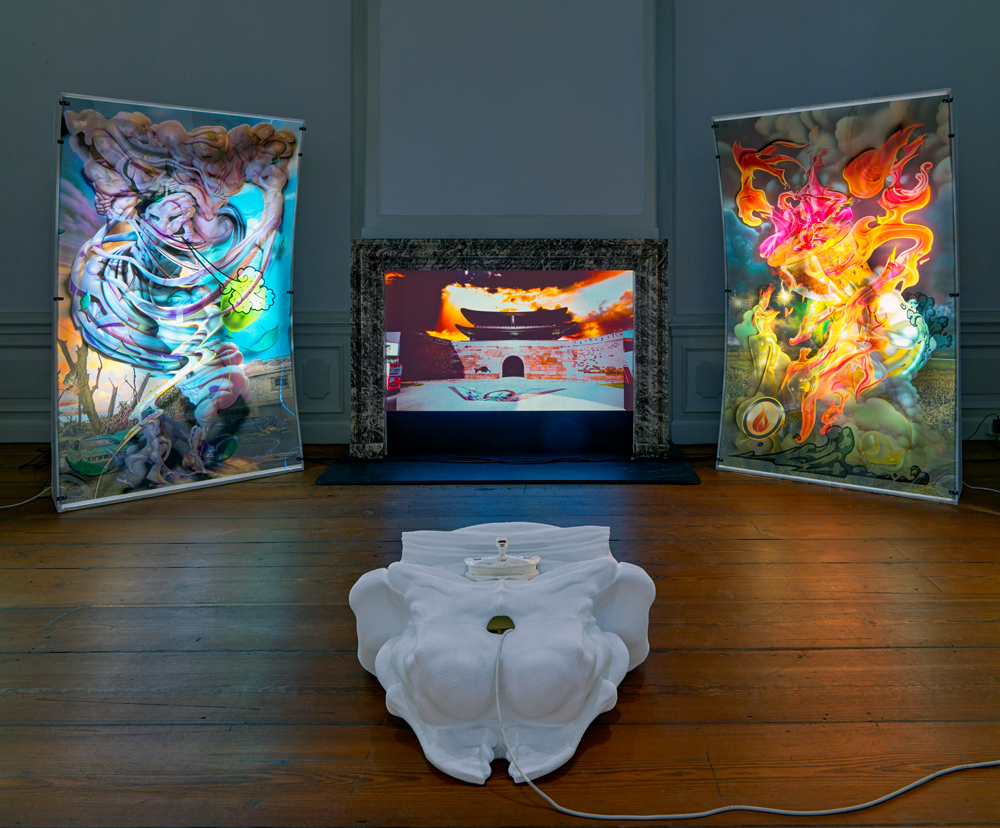
Kévin Bray, overview 'The Collective Shadow', photo's by Gert Jan van Rooij, courtesy Upstream Gallery
In his solo exhibition The Collective Shadow (14.1 – 25.2.2023), the French, Amsterdam-based artist Kévin Bray demonstrates his mastery of projection. The light of our modern world is cast into a liminal space between digital and IRL, and the shadows that dance in the periphery speak to us as the monsters of a repressed psychology. The title of the show draws from Carl Jung’s work on the unconscious mind. It was his mentor and predecessor Sigmund Freud who in the 1890s popularized the idea of projection as a repressive defense mechanism. Jung further developed this idea in his theories on the shadow side of our unconscious mind, writing: ‘A man who is possessed by his shadow is always standing in his own light and falling into his own traps.’
In the first room of the show is exactly this: two sculptural figures pose in a spotlight, clothed in shifting projectural textures, while their shadows dance behind them. There are layers here, of light and masks, of sounds and symbols. The shadows, themselves another masked figure on the wall behind, scream and snap their fingers, conjuring elemental powers of the natural world; fiery plumes and fierce winds – magicians at work. In the center of it all is the rotating planet Earth, projected into the room’s ceiling curvature. The two figures and their shadows form a duality of play around our spinning world. Is this an act of creation or destruction? The whole thing feels as though Bray has brought the hieroglyphs of a modern mythos to life, depicting either the origins or the downfall of our digital-physical age.
The de/construction of our world is ongoing, however, and shaped by our conscious as much as our unconscious actions. It’s in the second room of the exhibition that Bray further delves into this territory. Here, the wild and chaotic forms of the four natural elements stand like monoliths: fire, water, earth, and wind. Each is contained in a giant projection box, backlit by a bright light which illuminates multi-layered ‘quadriptych’ plexiglass. The backlight turns on and off intermittently, creating a shifting and at times disorienting visual collage of humanity’s relationship to these elements. Their forms are twisted and gnarled, sad monstrosities that sneer through the abs- and ex-traction of their resources.
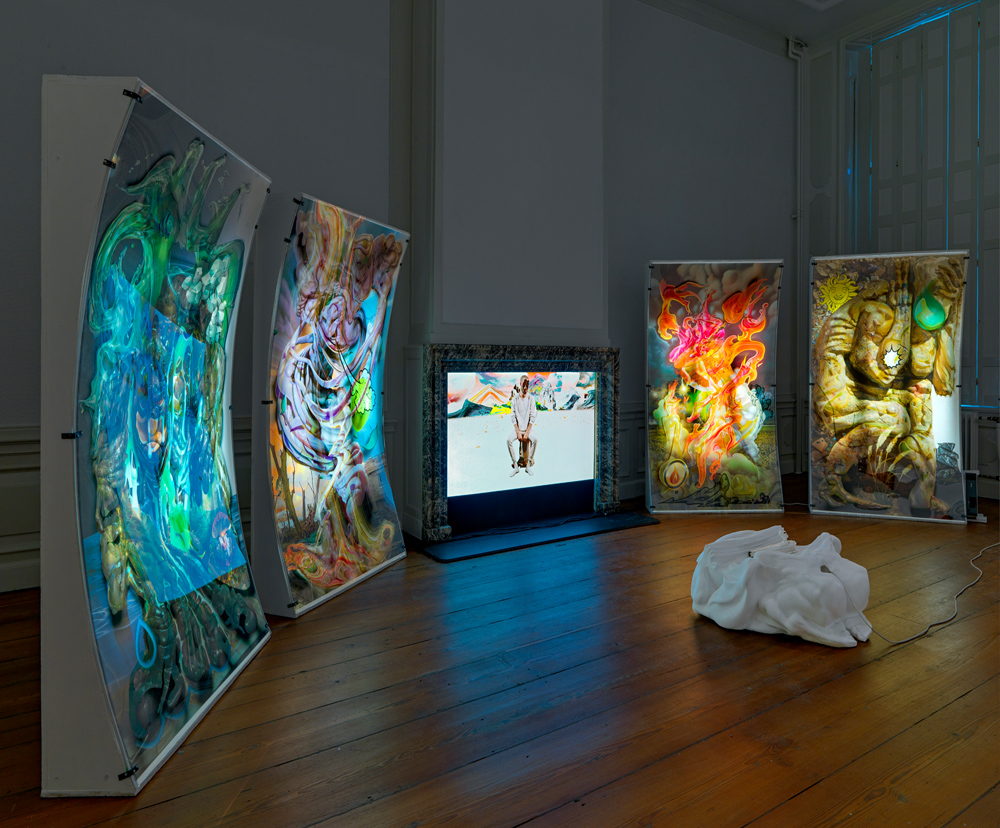
Kévin Bray, overview 'The Collective Shadow', photo's by Gert Jan van Rooij, courtesy Upstream Gallery
Into the uncanny valley
These elemental monsters preside over the work which forms the heart of the exhibition, Morpher (2018-ongoing), a video installation projected into the room’s hearth. The looping video acts as a personal journey through the world of The Collective Shadow, beginning by taking the viewer for a drive along a sunny coastal highway. After crashing through a screen-like fourth wall in the middle of the road, things get weird. The viewer is guided on an astral journey over fire-pocked mountains and through a literal uncanny valley. The surface of the valley is fragmented, its canyon walls divided into different undulating textures as though depicting the by-products of some novel digital harvest. More sculptural statues rise from the canyon, like monuments to our modern age, but their purpose seems pointless in these barren lands.
The viewer is guided on an astral journey over fire-pocked mountains and through a literal uncanny valley
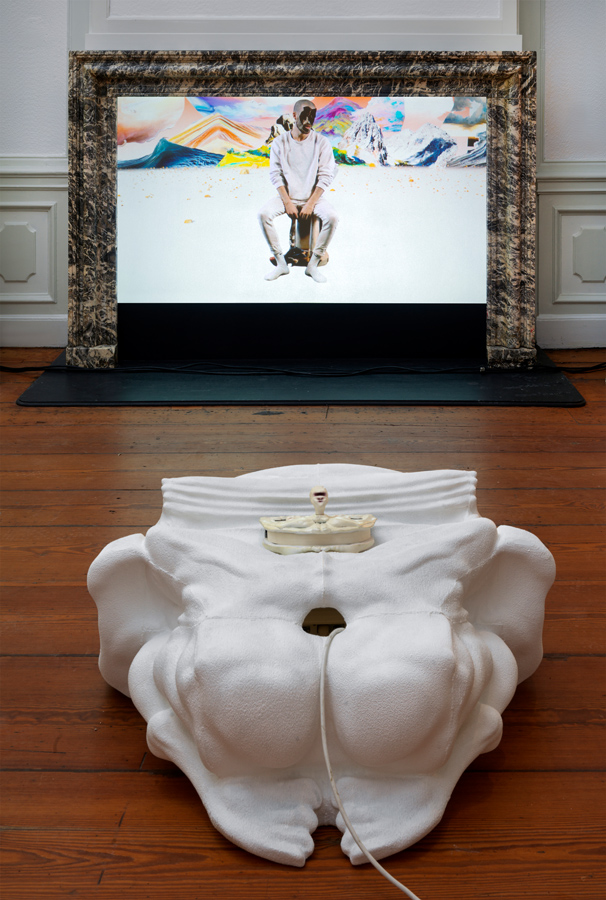
Kévin Bray, overview 'The Collective Shadow', photo's by Gert Jan van Rooij, courtesy Upstream Gallery
In any good monster myth a hero is needed. As Morpher finally touches down to the surface of a Mars-like landscape, an unlikely hero emerges: a scruffy ‘every-man’, dressed in casual sweats and socks, crash-lands with a cloud of dust. It is here that Bray really breaks through the fourth wall and addresses us, the collective audience on the other side of the screen. Multiple spotlights of attention take aim at the hero, and he squints back through the screen, pointing at us as we project upon him our ideas/identities/stereotypes. He speaks but his words are lost, and so he begins to sing. A mirror at the back of his head syncs to his movements, its surface cracked and reflecting the face of another: the artist, the viewer, the shadow-monster? His blue eyes gaze through the hero as he croons a simple melody. With a turn of the head the mirror flips around, confronting the hero who continues to sing, their eyes now locked. Synthesis ensues. The camera’s perspective flips around to inhabit the ‘every-man’, and we become the monster itself, staring down at scaly hands as though coming up on a bad trip. Finally, an exit to familiarity is revealed by – what else? – little invertebrate projection creatures.
It’s through this personal sequence of mask and mirror that the exhibition reaches a kind of numinous climax. Shadow-work has been done, and those tuned-in will be left with a feeling of post-therapy catharsis. Others may scratch their heads and, as after a vivid dream, wondering what it was all for. Morpher is a shapeshifting and ongoing work, shown previously at various European exhibitions in different iterations. Reworked here within the narrative arc of The Collective Shadow it seems to have found a powerful new identity.
It is watching
Lurking on the wall behind Morpher hangs a salon-style patchwork of canvased paintings depicting the shadow-monster in its many elusive forms. Like the mirrored mask, It has been watching us. It is filtering its needs (2022), It is coming for you (2022), It is producing clouds (2022), and many more It-titled canvases explore the monster’s many permutations. These grotesques form a jarring aesthetic, like a quantum-AI channeling Picasso with the palette of Windows XP. Bray is consistent with his bodily sculptural forms: all stylized appendages and twisted limbs, with textures that either thrill or sicken punctuated by the use of symbol. These techno-beasts, native to the screen, feel a bit like lifeless insects locked in amber when displayed on a wall of canvas. A projected bolt of lightning attempts to spark life, but it’s the radical clash of texture and form that gives these creatures their bite.
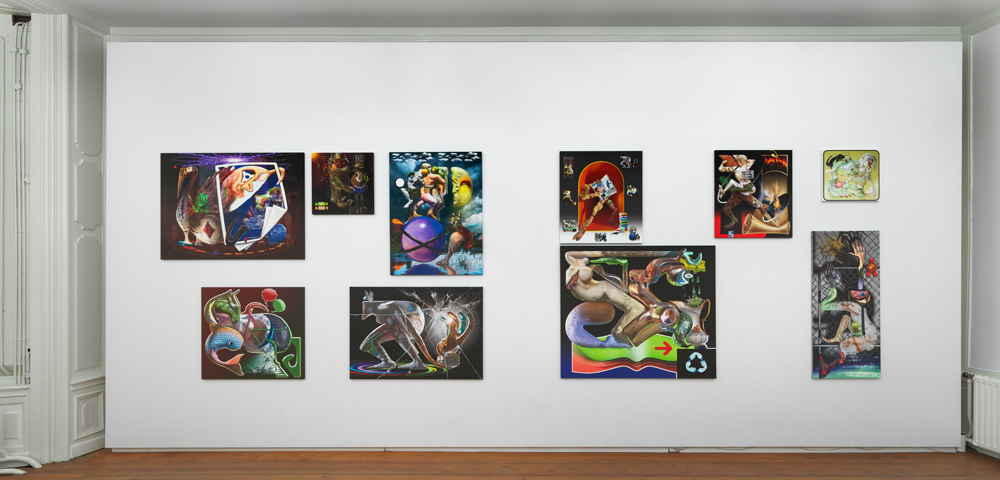
Kévin Bray, overview 'The Collective Shadow', photo's by Gert Jan van Rooij, courtesy Upstream Gallery

Kévin Bray, overview 'The Collective Shadow', photo's by Gert Jan van Rooij, courtesy Upstream Gallery
Bray casts a wide net for the scope of this exhibition, exploring the shadow on both the personal and the collective levels, and the resulting effects on both the physical and the digital world. The unwieldiness of this is tamed by Bray’s technical mercurialness and innovative projection techniques that merge these expansive spheres into some Gestalten whole. Wielding a range of tools, Bray peels back the curtain, revealing the shadowy forms of our modern psychology.
Ultimately, The Collective Shadow asks us to fill in the blanks with our own experiences – to project ourselves onto its many surfaces. Bray is careful not to tie himself to any signs or symbols of modern technological strife: there is no mention of ChatGPT or Stable Diffusion, of surveillance capitalism or social media, of strip-mining rainforests for precious motherboard metals. The exhibition is both of the past – with a nostalgia in early 00s internet aesthetic – and of the future – portending a host of meta-realities we have yet to plug ourselves into. The elision of the now allows for a blank spot on which to project our daily humanity and observe the shadows that begin to creep in. That the viewer is asked to do the heavy lifting is both the strength and weakness of this exhibition; those who do the shadow-work may be rewarded here. As Jung so aptly wrote, ‘One does not become enlightened by imagining figures of light, but by making the darkness conscious.’
The Collective Shadow is on view at Upstream Gallery until the 25th of February, 2023. Visit Upstream’s website for more information.
Jordan Ross Ellingwood
is a writer and artist in Amsterdam